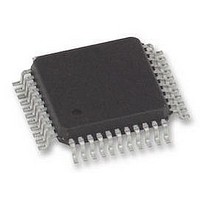FM6124-QG Ramtron, FM6124-QG Datasheet - Page 22

FM6124-QG
Manufacturer Part Number
FM6124-QG
Description
FRAM, 24KB, EVENT DATA REC, QFP44
Manufacturer
Ramtron
Datasheet
1.FM6124-QG.pdf
(53 pages)
Specifications of FM6124-QG
Memory Size
24KB
Nvram Features
RTC
Supply Voltage Range
3V To 3.6V
Memory Case Style
QFP
No. Of Pins
44
Operating Temperature Range
-40°C To +85°C
Package / Case
QFP
Interface
I2C
Memory
RoHS Compliant
Interface Type
I2C, Serial, 2-Wire
Rohs Compliant
Yes
Access Time
100 KBPs
Operating Supply Voltage
3 V to 3.6 V
Mounting Style
SMD/SMT
Lead Free Status / Rohs Status
Details
Available stocks
Company
Part Number
Manufacturer
Quantity
Price
Company:
Part Number:
FM6124-QG
Manufacturer:
ABOV
Quantity:
3 000
calibration and square wave outputs. When the RTC
calibration mode is invoked by setting the CAL bit
(register 00h, bit 2), the ACS output pin will be driven
with a 512 Hz square wave and the alarm will continue to
operate. Since most users only invoke the calibration mode
during production this should have no impact on the
otherwise normal operation of the alarm.
The ACS output may also be used to drive the system with
a frequency other than 512 Hz. The AL/SW bit (register
18h, bit 6) must be ‘0’. A user-selectable frequency is
provided by F0 and F1 (register 18h, bits 4 and 5). The
other frequencies are 1, 4096, and 32768 Hz.
Rev. 4.0 (EOL)
July 2010
Table 4. Alarm Match Bit Examples
Real-time Clock Operation
The real-time clock (RTC) is a timekeeping device
that can be capacitor- or battery-backed for
permanently-powered operation. It offers a software
calibration feature that allows high accuracy.
The RTC consists of an oscillator, clock divider, and
a register system for user access. It divides down the
32.768 kHz time-base and provides a minimum
resolution of seconds (1Hz). Static registers provide
the user with read/write access to the time values. It
includes registers for seconds, minutes, hours, day-
of-the-week, date, months, and years. A block
diagram shown in Figure 9 illustrates the RTC
function.
The user registers are synchronized with the
timekeeper core using R and W bits in register 00h.
The R bit is used to read the time. Changing the R bit
from 0 to 1 transfers timekeeping information from
the core into the user registers 02-08h that can be
Seconds
1
0
0
0
0
Minutes
1
1
0
0
0
Hours
1
1
1
0
0
Date
1
1
1
1
0
Months
1
1
1
1
1
If a
Alarm condition
No match required = alarm 1/second
Alarm when seconds match = alarm 1/minute
Alarm when seconds, minutes match = alarm 1/hour
Alarm when seconds, minutes, hours match = alarm 1/date
Alarm when seconds, minutes, hours, date match = alarm 1/month
continuous frequency output is enabled with CAL mode,
the alarm function will not be available.
Following is a summary table that shows the relationship
between register control settings and the state of the ACS
pin.
read by the user. If a timekeeper update is pending
when R is set, then the core will be updated prior to
loading the user registers. The user registers are
frozen and will not be updated again until the R bit is
cleared to a ‘0’.
The W bit is used to write new time/date values.
Setting the W bit to a ‘1’ stops the RTC and allows
the timekeeping core to be written with new data.
Clearing it to ‘0’ causes the RTC to start running
based on the new values loaded in the timekeeper
core. The RTC may be synchronized to another clock
source. On the 8
(W=0), the RTC starts counting with a timebase that
has been reset to zero milliseconds.
Note: Users should be certain not to load invalid
values, such as FFh, to the timekeeping registers.
Updates to the timekeeping core occur continuously
except when locked.
Table 3.
CAL
State of Register Bit
0
0
1
0
th
AEN
X
X
clock of the write to register 00h
1
0
AL/SW
X
1
0
1
Sq Wave out
Function of
512 Hz out
ACS pin
/Alarm
Page 22 of 53
Hi-Z













